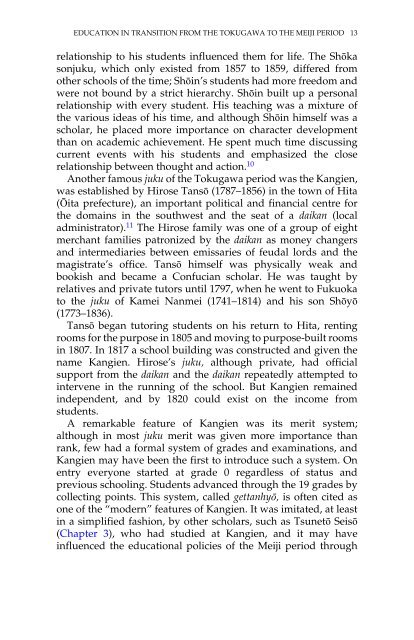Private Academies of Chinese Learning in Meiji Japan: The Decline ...
Private Academies of Chinese Learning in Meiji Japan: The Decline ...
Private Academies of Chinese Learning in Meiji Japan: The Decline ...
Create successful ePaper yourself
Turn your PDF publications into a flip-book with our unique Google optimized e-Paper software.
EDUCATION IN TRANSITION FROM THE TOKUGAWA TO THE MEIJI PERIOD 13relationship to his students <strong>in</strong>fluenced them for life. <strong>The</strong> Shōkasonjuku, which only existed from 1857 to 1859, differed fromother schools <strong>of</strong> the time; Shō<strong>in</strong>’s students had more freedom andwere not bound by a strict hierarchy. Shō<strong>in</strong> built up a personalrelationship with every student. His teach<strong>in</strong>g was a mixture <strong>of</strong>the various ideas <strong>of</strong> his time, and although Shō<strong>in</strong> himself was ascholar, he placed more importance on character developmentthan on academic achievement. He spent much time discuss<strong>in</strong>gcurrent events with his students and emphasized the closerelationship between thought and action. 10Another famous juku <strong>of</strong> the Tokugawa period was the Kangien,was established by Hirose Tansō (1787–1856) <strong>in</strong> the town <strong>of</strong> Hita(Ōita prefecture), an important political and f<strong>in</strong>ancial centre forthe doma<strong>in</strong>s <strong>in</strong> the southwest and the seat <strong>of</strong> a daikan (localadm<strong>in</strong>istrator). 11 <strong>The</strong> Hirose family was one <strong>of</strong> a group <strong>of</strong> eightmerchant families patronized by the daikan as money changersand <strong>in</strong>termediaries between emissaries <strong>of</strong> feudal lords and themagistrate’s <strong>of</strong>fice. Tansō himself was physically weak andbookish and became a Confucian scholar. He was taught byrelatives and private tutors until 1797, when he went to Fukuokato the juku <strong>of</strong> Kamei Nanmei (1741–1814) and his son Shōyō(1773–1836).Tansō began tutor<strong>in</strong>g students on his return to Hita, rent<strong>in</strong>grooms for the purpose <strong>in</strong> 1805 and mov<strong>in</strong>g to purpose-built rooms<strong>in</strong> 1807. In 1817 a school build<strong>in</strong>g was constructed and given thename Kangien. Hirose’s juku, although private, had <strong>of</strong>ficialsupport from the daikan and the daikan repeatedly attempted to<strong>in</strong>tervene <strong>in</strong> the runn<strong>in</strong>g <strong>of</strong> the school. But Kangien rema<strong>in</strong>ed<strong>in</strong>dependent, and by 1820 could exist on the <strong>in</strong>come fromstudents.A remarkable feature <strong>of</strong> Kangien was its merit system;although <strong>in</strong> most juku merit was given more importance thanrank, few had a formal system <strong>of</strong> grades and exam<strong>in</strong>ations, andKangien may have been the first to <strong>in</strong>troduce such a system. Onentry everyone started at grade 0 regardless <strong>of</strong> status andprevious school<strong>in</strong>g. Students advanced through the 19 grades bycollect<strong>in</strong>g po<strong>in</strong>ts. This system, called gettanhyō, is <strong>of</strong>ten cited asone <strong>of</strong> the “modern” features <strong>of</strong> Kangien. It was imitated, at least<strong>in</strong> a simplified fashion, by other scholars, such as Tsunetō Seisō(Chapter 3), who had studied at Kangien, and it may have<strong>in</strong>fluenced the educational policies <strong>of</strong> the <strong>Meiji</strong> period through













